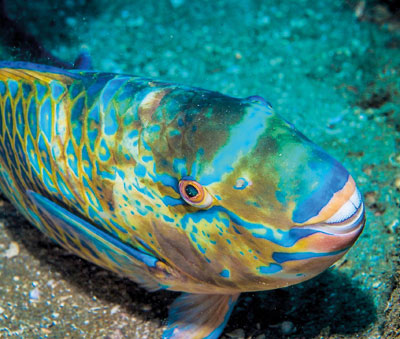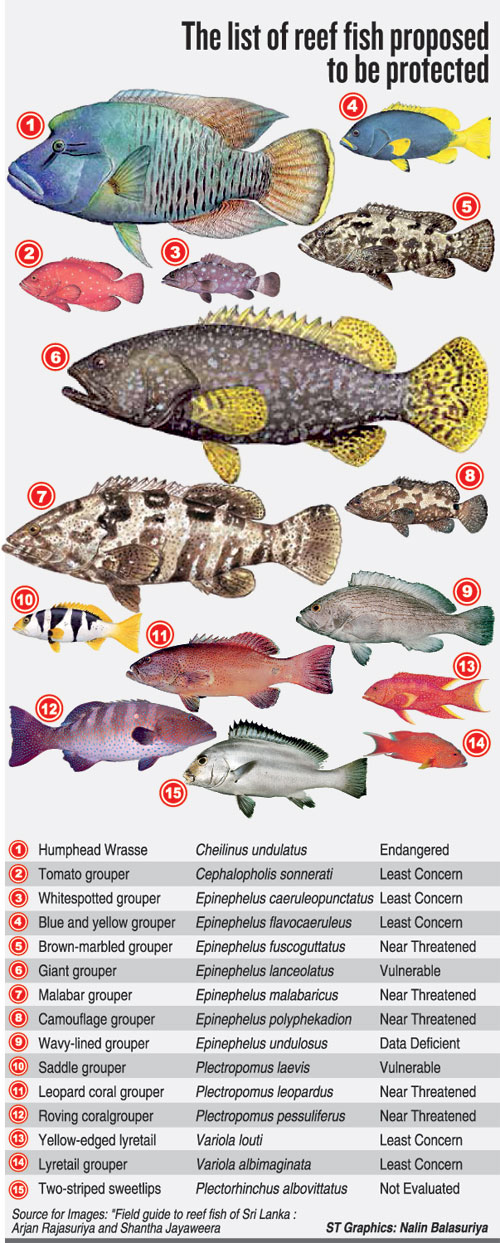News
Alarm bells ring for popular reef fish

A beautiful parrotfish photographed in Colombo. Pic by Dharshana Jayawardena
Sri Lanka will need to protect its overexploited coral reef fish which are rapidly becoming rarer, conservationists believe.
Gal malu, or rock fish, are generally popular in the country and these include varieties of grouper and parrot fish (girawa).
The National Aquatic Resources Research and Development Agency (NARA) initiated a study in January to asses status of ‚Äėedible reef fish‚Äô commonly known as ‚Äėgal malu‚Äô. The study will take about a year, the Sunday Times learns.
‚ÄúThe size of fish caught is smaller on average. Fishermen now must use more fishing gear to catch a similar volume of fish they caught a decade ago. This alone indicates the depletion of edible ‚Äėgal malu‚Äô populations,‚ÄĚ points out Dr Sisira Haputantri ‚Äď the head of Marine Biology Division of NARA.
The killing of a human-sized humphead wrasse (cheilinus undulates) in Unawatuna by spearfishing two weeks ago helped intensity demands for a ban on spearfishing.
The Director General of the Department of Fisheries & Aquatic Resources, M C L Fernando, said a proposal to ban spearfishing is now being reviewed by the government’s law drafters.
Action has been also taken to ban the fishing of tomato grouper (cephalopholis sonnerati) ‚Äď a beautiful coral fish known as ‚Äėran thambuva‚Äô locally. Tomato grouper inhabits holes in the reef with cleaner shrimp and helps maintain the hiding places by fanning out sand. Scarlet shrimp and painted shrimp are high value items in the ornamental fish trade and without the groupers, the shrimp populations would die out.
Many other reef fish are threatened by overfishing and high consumption locally and overseas. The SundayTimes reported last week that the Sub-Aqua Club has appealed to the Minister of Fisheries to protect 15 large coral fish. Most of them are groupers and listed under threatened categories in the International Union for Conservation of Nature Red List with the humphead wrasse being listed as ‚Äėendangered‚Äô. However, the DG of the Fisheries Department is not convinced of the threat facing these fish and insists on a study to assess the situation.
But marine biologists and divers that the Sunday Times contacted say their encounters with large reef fish are becoming rarer, which itself is an indication of their vulnerability.
Meanwhile, news emerged this week that the Fisheries Minister Mahinda Amaraweera wants to ban the fishing of parrotfish.
When contacted, the minister also said that the fishing of parrotfish no smaller than 500 grams will not be allowed. But, the Sunday Times found out from the DG of Fisheries that there are no immediate plans to ban the fishing of parrotfish and that such a move would be based on the study on reef fish.
The parrotfish inhabits coral reefs and feed on algae growing on the reef. There are about 10 different species of parrotfish in Sri Lanka. Thankfully, locally there is not much demand for it as a food fish.
Unfortunately though, this beautiful fish is in high demand among Chinese. There are suspicions and fears that the appearance of parrotfish in local supermarkets is to cater to demand from increasing numbers of Chinese living and visiting Sri Lanka.
Arjan Rajasuriya Coordinator, Coastal & Marine Programme IUCN Sri Lanka emphasises that fish stocks of Sri Lanka need to be monitored regularly, especially to check whether demand has grown in recent years for species that had not been sought-after previously.
He also notes that reef fish are threatened due to pollution, invasive alien species, climate change, and illegal fishing methods such as dynamiting. Conservation is necessary before its too late, he said.


